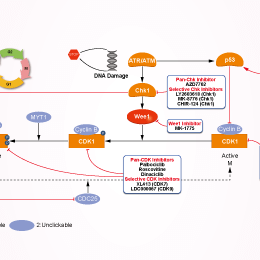
- Bioactive Compounds
- By Signaling Pathways
- PI3K/Akt/mTOR
- Epigenetics
- Methylation
- Immunology & Inflammation
- Protein Tyrosine Kinase
- Angiogenesis
- Apoptosis
- Autophagy
- ER stress & UPR
- JAK/STAT
- MAPK
- Cytoskeletal Signaling
- Cell Cycle
- TGF-beta/Smad
- DNA Damage/DNA Repair
- Compound Libraries
- Popular Compound Libraries
- Customize Library
- Clinical and FDA-approved Related
- Bioactive Compound Libraries
- Inhibitor Related
- Natural Product Related
- Metabolism Related
- Cell Death Related
- By Signaling Pathway
- By Disease
- Anti-infection and Antiviral Related
- Neuronal and Immunology Related
- Fragment and Covalent Related
- FDA-approved Drug Library
- FDA-approved & Passed Phase I Drug Library
- Preclinical/Clinical Compound Library
- Bioactive Compound Library-I
- Bioactive Compound Library-Ⅱ
- Kinase Inhibitor Library
- Express-Pick Library
- Natural Product Library
- Human Endogenous Metabolite Compound Library
- Alkaloid Compound LibraryNew
- Angiogenesis Related compound Library
- Anti-Aging Compound Library
- Anti-alzheimer Disease Compound Library
- Antibiotics compound Library
- Anti-cancer Compound Library
- Anti-cancer Compound Library-Ⅱ
- Anti-cancer Metabolism Compound Library
- Anti-Cardiovascular Disease Compound Library
- Anti-diabetic Compound Library
- Anti-infection Compound Library
- Antioxidant Compound Library
- Anti-parasitic Compound Library
- Antiviral Compound Library
- Apoptosis Compound Library
- Autophagy Compound Library
- Calcium Channel Blocker LibraryNew
- Cambridge Cancer Compound Library
- Carbohydrate Metabolism Compound LibraryNew
- Cell Cycle compound library
- CNS-Penetrant Compound Library
- Covalent Inhibitor Library
- Cytokine Inhibitor LibraryNew
- Cytoskeletal Signaling Pathway Compound Library
- DNA Damage/DNA Repair compound Library
- Drug-like Compound Library
- Endoplasmic Reticulum Stress Compound Library
- Epigenetics Compound Library
- Exosome Secretion Related Compound LibraryNew
- FDA-approved Anticancer Drug LibraryNew
- Ferroptosis Compound Library
- Flavonoid Compound Library
- Fragment Library
- Glutamine Metabolism Compound Library
- Glycolysis Compound Library
- GPCR Compound Library
- Gut Microbial Metabolite Library
- HIF-1 Signaling Pathway Compound Library
- Highly Selective Inhibitor Library
- Histone modification compound library
- HTS Library for Drug Discovery
- Human Hormone Related Compound LibraryNew
- Human Transcription Factor Compound LibraryNew
- Immunology/Inflammation Compound Library
- Inhibitor Library
- Ion Channel Ligand Library
- JAK/STAT compound library
- Lipid Metabolism Compound LibraryNew
- Macrocyclic Compound Library
- MAPK Inhibitor Library
- Medicine Food Homology Compound Library
- Metabolism Compound Library
- Methylation Compound Library
- Mouse Metabolite Compound LibraryNew
- Natural Organic Compound Library
- Neuronal Signaling Compound Library
- NF-κB Signaling Compound Library
- Nucleoside Analogue Library
- Obesity Compound Library
- Oxidative Stress Compound LibraryNew
- Plant Extract Library
- Phenotypic Screening Library
- PI3K/Akt Inhibitor Library
- Protease Inhibitor Library
- Protein-protein Interaction Inhibitor Library
- Pyroptosis Compound Library
- Small Molecule Immuno-Oncology Compound Library
- Mitochondria-Targeted Compound LibraryNew
- Stem Cell Differentiation Compound LibraryNew
- Stem Cell Signaling Compound Library
- Natural Phenol Compound LibraryNew
- Natural Terpenoid Compound LibraryNew
- TGF-beta/Smad compound library
- Traditional Chinese Medicine Library
- Tyrosine Kinase Inhibitor Library
- Ubiquitination Compound Library
-
Cherry Picking
You can personalize your library with chemicals from within Selleck's inventory. Build the right library for your research endeavors by choosing from compounds in all of our available libraries.
Please contact us at info@selleckchem.com to customize your library.
You could select:
- Antibodies
- Bioreagents
- qPCR
- 2x SYBR Green qPCR Master Mix
- 2x SYBR Green qPCR Master Mix(Low ROX)
- 2x SYBR Green qPCR Master Mix(High ROX)
- Protein Assay
- Protein A/G Magnetic Beads for IP
- Anti-Flag magnetic beads
- Anti-Flag Affinity Gel
- Anti-Myc magnetic beads
- Anti-HA magnetic beads
- Poly DYKDDDDK Tag Peptide lyophilized powder
- Protease Inhibitor Cocktail
- Protease Inhibitor Cocktail (EDTA-Free, 100X in DMSO)
- Phosphatase Inhibitor Cocktail (2 Tubes, 100X)
- Cell Biology
- Cell Counting Kit-8 (CCK-8)
- Animal Experiment
- Mouse Direct PCR Kit (For Genotyping)
- New Products
- Contact Us
Adavosertib (MK-1775)
Synonyms: AZD1775
Adavosertib (MK-1775, AZD1775) is a potent and selective Wee1 inhibitor with IC50 of 5.2 nM in a cell-free assay; hinders G2 DNA damage checkpoint. Phase 2.
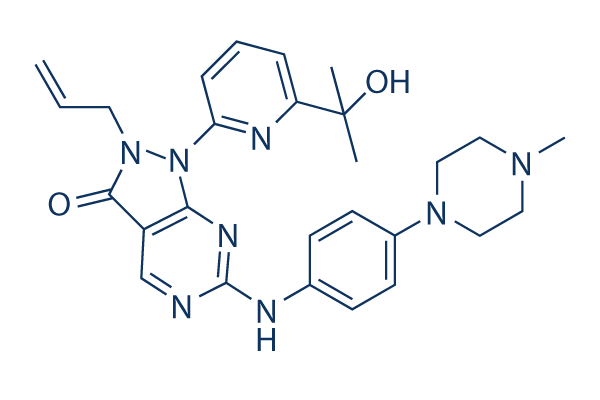
Adavosertib (MK-1775) Chemical Structure
CAS No. 955365-80-7
Purity & Quality Control
Batch:
Purity:
99.99%
99.99
Adavosertib (MK-1775) Related Products
| Related Products | PD0166285 | Click to Expand |
|---|---|---|
| Related Compound Libraries | Kinase Inhibitor Library PI3K/Akt Inhibitor Library MAPK Inhibitor Library DNA Damage/DNA Repair compound Library Cell Cycle compound library | Click to Expand |
Signaling Pathway
Cell Data
| Cell Lines | Assay Type | Concentration | Incubation Time | Formulation | Activity Description | PMID |
|---|---|---|---|---|---|---|
| ASPC-1 | Growth Inhibition Assay | IC50=13.2 ± 1.1 μM | 25458954 | |||
| BxPC-3 | Growth Inhibition Assay | IC50=0.8 ± 0.03 μM | 25458954 | |||
| CFPAC-1 | Growth Inhibition Assay | IC50=3.3 ± 0.2 μM | 25458954 | |||
| HPAC | Growth Inhibition Assay | IC50=0.5 ± 0.01 μM | 25458954 | |||
| MIAPaCa-2 | Growth Inhibition Assay | IC50=0.5 ± 0.05 μM | 25458954 | |||
| PANC-1 | Growth Inhibition Assay | IC50=10.6 ± 1.1 μM | 25458954 | |||
| SK-N-BE (2) | Growth Inhibition Assay | IC50=2.4 ± 0.3 μM | 25308916 | |||
| SK-N-BE (2), PAN→MK | Growth Inhibition Assay | IC50=26.6 ± 9.6 μM | 25308916 | |||
| SK-N-BE (2), MK→PAN | Growth Inhibition Assay | IC50=2.4 ± 0.3 μM | 25308916 | |||
| SK-N-AS | Growth Inhibition Assay | IC50=0.50 ± 0.02 μM | 25308916 | |||
| SK-N-DZ | Growth Inhibition Assay | IC50=0.36 ± 0.01 μM | 25308916 | |||
| SK-N-AS | Apoptosis Assay | 500 nM | 48 h | induces cell apoptosis | 25308916 | |
| SK-N-DZ | Apoptosis Assay | 500 nM | 48 h | induces cell apoptosis | 25308916 | |
| THP-1 | Growth Inhibition Assay | 125/250/500 nM | 48 h | increases cell death in a concentration-dependent manner | 25084614 | |
| MV4-11 | Growth Inhibition Assay | 125/250/500 nM | 48 h | increases cell death in a concentration-dependent manner | 25084614 | |
| U937 | Growth Inhibition Assay | 125/250/500 nM | 48 h | increases cell death in a concentration-dependent manner | 25084614 | |
| HL-60 | Growth Inhibition Assay | 125/250/500 nM | 48 h | increases cell death in a concentration-dependent manner | 25084614 | |
| OCI-AML3 | Growth Inhibition Assay | 125/250/500 nM | 48 h | increases cell death in a concentration-dependent manner | 25084614 | |
| MOLM-13 | Growth Inhibition Assay | 125/250/500 nM | 48 h | increases cell death in a concentration-dependent manner | 25084614 | |
| CMK | Cell Viability Assay | 10-10000 nM | 72 h | reduces cell vialibity in a concentration-dependent manner | 24962331 | |
| CMY | Cell Viability Assay | 10-10000 nM | 72 h | reduces cell vialibity in a concentration-dependent manner | 24962331 | |
| Dayo | Growth Inhibition Assay | IC50=150 nM | 24661910 | |||
| UW228 | Growth Inhibition Assay | IC50=232 nM | 24661910 | |||
| IST-MES1 | Cell Viability Assay | 150/250 nM | 72 h | enhances the cisplatin cytotoxic effect in a concentration-dependent manner | 24365782 | |
| IST-MES2 | Cell Viability Assay | 150/250 nM | 72 h | enhances the cisplatin cytotoxic effect in a concentration-dependent manner | 24365782 | |
| REN | Cell Viability Assay | 150/250 nM | 72 h | enhances the cisplatin cytotoxic effect in a concentration-dependent manner | 24365782 | |
| NCI-H2452 | Cell Viability Assay | 150/250 nM | 72 h | enhances the cisplatin cytotoxic effect in a concentration-dependent manner | 24365782 | |
| MSTO-211H | Cell Viability Assay | 150/250 nM | 72 h | enhances the cisplatin cytotoxic effect in a concentration-dependent manner | 24365782 | |
| NCI-H2052 | Cell Viability Assay | 150/250 nM | 72 h | enhances the cisplatin cytotoxic effect in a concentration-dependent manner | 24365782 | |
| WEE1 | Growth Inhibition Assay | IC50=5.2 nM | 23699655 | |||
| CDC2 | Growth Inhibition Assay | IC50>1000 nM | 23699655 | |||
| CDK7 | Growth Inhibition Assay | IC50>1000 nM | 23699655 | |||
| MYT1 | Growth Inhibition Assay | IC50=530 nM | 23699655 | |||
| T98G | Apoptosis Assay | 100/250 nM | 6 h | enhances radiation-induced cell killing | 21992793 | |
| A549 | Apoptosis Assay | 200 nM | 1 h | radiosensitizes NSCLC cells in a p53-dependent manner | 21799033 | |
| H460 | Apoptosis Assay | 200 nM | 1 h | radiosensitizes NSCLC cells in a p53-dependent manner | 21799033 | |
| H1299 | Apoptosis Assay | 200 nM | 1 h | radiosensitizes NSCLC cells in a p53-dependent manner | 21799033 | |
| Calu-6 | Apoptosis Assay | 200 nM | 1 h | radiosensitizes NSCLC cells in a p53-dependent manner | 21799033 | |
| WiDr | Kinase Assays | 10-10000 nM | 8 h | inhibits phosphorylation of CDC2 at Tyr15 with an EC50 value of 85 nmol/L pretreated with gemcitabine | 19887545 | |
| Function assay | Expi293F | Binding affinity to recombinant human full-length N-terminal His8-tagged Wee1 (1 to 646 residues) expressed in human Expi293F cells assessed as dessociation constant by quantitative real-time PCR method, Kd = 0.0032 μM. | 28792760 | |||
| Function assay | Expi293F | Binding affinity to recombinant human full-length N-terminal His8-tagged Wee2 (1 to 567 residues) expressed in human Expi293F cells assessed as dessociation constant by quantitative real-time PCR method, Kd = 0.0039 μM. | 28792760 | |||
| Antiproliferative assay | MDA-MB-231 | 72 hrs | Antiproliferative activity against human MDA-MB-231 cells measured after 72 hrs by CellTiter-Blue assay, IC50 = 0.26 μM. | 28792760 | ||
| Antiproliferative assay | HEK293T | 72 hrs | Antiproliferative activity against HEK293T cells measured after 72 hrs by CellTiter-Blue assay, IC50 = 0.29 μM. | 28792760 | ||
| Antiproliferative assay | MM1S | 72 hrs | Antiproliferative activity against human MM1S cells measured after 72 hrs by CellTiter-Blue assay, IC50 = 0.31 μM. | 28792760 | ||
| Function assay | HEK293 | 1 hr | Inhibition of human full length PKMYT1 expressed in HEK293 cells using EFS (247 to 259 residues) as substrate after 1 hr by fluorescence polarization immunoasay, Ki = 0.47 μM. | 29941193 | ||
| Function assay | HEK293 | 1 hr | Inhibition of human full length PKMYT1 expressed in HEK293 cells using EFS (247 to 259 residues) as substrate after 1 hr by fluorescence polarization immunoasay, IC50 = 4.94 μM. | 29941193 | ||
| Function assay | MDA-MB-231 | 0.1 to 10 uM | 6 hrs | Inhibition of Wee1 in human MDA-MB-231 cells assessed as decrease in CDK1 phosphorylation at Tyr 15 at 0.1 to 10 uM after 6 hrs by Western blot method | 28792760 | |
| Function assay | HEK293T | 0.1 to 10 uM | 6 hrs | Inhibition of Wee1 in HEK293T cells assessed as decrease in CDK1 phosphorylation at Tyr15 at 0.1 to 10 uM after 6 hrs by Western blot method | 28792760 | |
| Function assay | HEK293T | 0.1 to 10 uM | 6 hrs | Inhibition of PLK1 in HEK293T cells assessed as decrease in TCTP phosphorylation at 0.1 to 10 uM after 6 hrs by Western blot method | 28792760 | |
| Function assay | MDA-MB-23 | 0.1 to 10 uM | 6 hrs | Inhibition of PLK1 in human MDA-MB-23 cells assessed as decrease in TCTP phosphorylation at 0.1 to 10 uM after 6 hrs by Western blot method | 28792760 | |
| qHTS assay | TC32 | qHTS of pediatric cancer cell lines to identify multiple opportunities for drug repurposing: Primary screen for TC32 cells | 29435139 | |||
| qHTS assay | U-2 OS | qHTS of pediatric cancer cell lines to identify multiple opportunities for drug repurposing: Primary screen for U-2 OS cells | 29435139 | |||
| qHTS assay | A673 | qHTS of pediatric cancer cell lines to identify multiple opportunities for drug repurposing: Primary screen for A673 cells | 29435139 | |||
| qHTS assay | DAOY | qHTS of pediatric cancer cell lines to identify multiple opportunities for drug repurposing: Primary screen for DAOY cells | 29435139 | |||
| qHTS assay | Saos-2 | qHTS of pediatric cancer cell lines to identify multiple opportunities for drug repurposing: Primary screen for Saos-2 cells | 29435139 | |||
| qHTS assay | BT-37 | qHTS of pediatric cancer cell lines to identify multiple opportunities for drug repurposing: Primary screen for BT-37 cells | 29435139 | |||
| qHTS assay | RD | qHTS of pediatric cancer cell lines to identify multiple opportunities for drug repurposing: Primary screen for RD cells | 29435139 | |||
| qHTS assay | SK-N-SH | qHTS of pediatric cancer cell lines to identify multiple opportunities for drug repurposing: Primary screen for SK-N-SH cells | 29435139 | |||
| qHTS assay | BT-12 | qHTS of pediatric cancer cell lines to identify multiple opportunities for drug repurposing: Primary screen for BT-12 cells | 29435139 | |||
| qHTS assay | NB1643 | qHTS of pediatric cancer cell lines to identify multiple opportunities for drug repurposing: Primary screen for NB1643 cells | 29435139 | |||
| qHTS assay | OHS-50 | qHTS of pediatric cancer cell lines to identify multiple opportunities for drug repurposing: Primary screen for OHS-50 cells | 29435139 | |||
| qHTS assay | BT-12 | qHTS of pediatric cancer cell lines to identify multiple opportunities for drug repurposing: Confirmatory screen for BT-12 cells | 29435139 | |||
| qHTS assay | DAOY | qHTS of pediatric cancer cell lines to identify multiple opportunities for drug repurposing: Confirmatory screen for DAOY cells | 29435139 | |||
| qHTS assay | SK-N-SH | qHTS of pediatric cancer cell lines to identify multiple opportunities for drug repurposing: Confirmatory screen for SK-N-SH cells | 29435139 | |||
| qHTS assay | Rh41 | qHTS of pediatric cancer cell lines to identify multiple opportunities for drug repurposing: Primary screen for Rh41 cells | 29435139 | |||
| qHTS assay | A673 | qHTS of pediatric cancer cell lines to identify multiple opportunities for drug repurposing: Confirmatory screen for A673 cells) | 29435139 | |||
| qHTS assay | MG 63 (6-TG R) | qHTS of pediatric cancer cell lines to identify multiple opportunities for drug repurposing: Confirmatory screen for MG 63 (6-TG R) cells | 29435139 | |||
| qHTS assay | U-2 OS | qHTS of pediatric cancer cell lines to identify multiple opportunities for drug repurposing: Confirmatory screen for U-2 OS cells | 29435139 | |||
| qHTS assay | OHS-50 | qHTS of pediatric cancer cell lines to identify multiple opportunities for drug repurposing: Confirmatory screen for OHS-50 cells | 29435139 | |||
| qHTS assay | Rh41 | qHTS of pediatric cancer cell lines to identify multiple opportunities for drug repurposing: Confirmatory screen for Rh41 cells | 29435139 | |||
| qHTS assay | RD | qHTS of pediatric cancer cell lines to identify multiple opportunities for drug repurposing: Confirmatory screen for RD cells | 29435139 | |||
| qHTS assay | SJ-GBM2 | qHTS of pediatric cancer cell lines to identify multiple opportunities for drug repurposing: Primary screen for SJ-GBM2 cells | 29435139 | |||
| qHTS assay | SK-N-MC | qHTS of pediatric cancer cell lines to identify multiple opportunities for drug repurposing: Primary screen for SK-N-MC cells | 29435139 | |||
| qHTS assay | NB-EBc1 | qHTS of pediatric cancer cell lines to identify multiple opportunities for drug repurposing: Primary screen for NB-EBc1 cells | 29435139 | |||
| qHTS assay | LAN-5 | qHTS of pediatric cancer cell lines to identify multiple opportunities for drug repurposing: Primary screen for LAN-5 cells | 29435139 | |||
| qHTS assay | Rh18 | qHTS of pediatric cancer cell lines to identify multiple opportunities for drug repurposing: Primary screen for Rh18 cells | 29435139 | |||
| qHTS assay | SJ-GBM2 | qHTS of pediatric cancer cell lines to identify multiple opportunities for drug repurposing: Confirmatory screen for SJ-GBM2 cells | 29435139 | |||
| qHTS assay | Saos-2 | qHTS of pediatric cancer cell lines to identify multiple opportunities for drug repurposing: Confirmatory screen for Saos-2 cells | 29435139 | |||
| Click to View More Cell Line Experimental Data | ||||||
Biological Activity
| Description | Adavosertib (MK-1775, AZD1775) is a potent and selective Wee1 inhibitor with IC50 of 5.2 nM in a cell-free assay; hinders G2 DNA damage checkpoint. Phase 2. | ||
|---|---|---|---|
| Features | The first reported Wee1 inhibitor. | ||
| Targets |
|
| In vitro | ||||
| In vitro | MK-1775 inhibits Wee1 kinase in an ATP-competitive manner. Compared to Wee1, MK-1775 displays 2- to 3-fold less potency against Yes with IC50 of 14 nM, 10-fold less potency against seven other kinases with >80% inhibition at 1 μM, and >100-fold selectivity over human Myt 1, another kinase that inhibits cyclin-dependent kinase 1 (CDC2) by phosphorylation at an alternative site (Thr14). By abrogating the DNA damage checkpoint via blockade of Wee1 activity in WiDr cells bearing mutated p53, MK-1775 treatment inhibits the basal phosphorylation of CDC2 at Tyr15 (CDC2Y15) with EC50 of 49 nM, and suppresses induced phosphorylation of CDC2 and cell cycle arrest in a dose-dependent manner, with EC50 of 82 nM and 81 nM, 180 nM and 163 nM, as well as 159 nM and 160 nM, respectively. MK-1775 treatment alone at 30-100 nM has no significant antiproliferative effect in WiDr and H1299 cells, whereas MK-1775 at 300 nM, sufficient to inhibit Wee1 by >80%, displays moderate but significant antiproliferative effects by 34.1% in WiDr cells and 28.4% in H1299 cells. [1] |
|||
|---|---|---|---|---|
| Kinase Assay | In vitro kinase assays | |||
| Recombinant human Wee1 is used. Kinase reaction is conducted with 10 μM ATP, 1.0 μCi of [γ-33P]ATP, and 2.5 μg of poly(Lys, Tyr) as a substrate in the presence of increasing concentrations of MK-1775 at 30°C for 30 minutes. Radioactivity incorporated into the substrate is trapped on MultiScreen-PH plates and is counted on a liquid scintillation counter. | ||||
| Cell Research | Cell lines | WiDr, NCI-H1299, TOV21G, and HeLa | ||
| Concentrations | Dissolved in DMSO, final concentrations ~10 μM | |||
| Incubation Time | 24 hours | |||
| Method | Cells are treated for 24 hours, then with MK-1775 for an additional 24 hours. Cell viability is determined with a WST-8 kit using SpectraMax. Cellular caspase-3/7 activities are determined with a Caspase-3/7 Glo kit. |
|||
| Experimental Result Images | Methods | Biomarkers | Images | PMID |
| Western blot | p-Cdk1(Y15) / Cdk1 p-KAP1(S824) / p-Chk2(T68) / p-Chk1(S345) PARP / CF-PARP / pH3(S10) / p-CDC25c(S216) / p-CDK2(Y15) WEE1 |
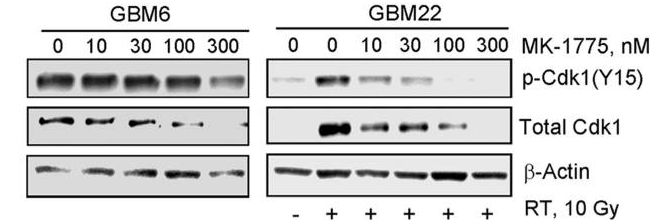
|
25609063 | |
| Immunofluorescence | tubulin / p-HH3(S10) γH2AX Cleaved caspase-3 / pH3 |
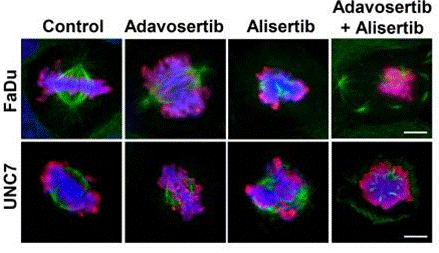
|
30755439 | |
| Growth inhibition assay | Cell viability IC50 |
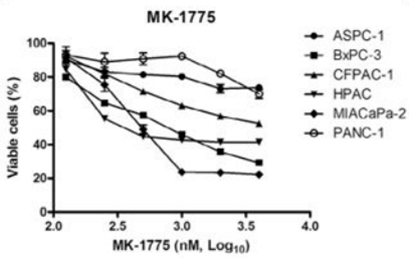
|
25458954 | |
| In Vivo | ||
| In vivo | MK-1775 treatment alone at ~20 mg/kg displays minimal antitumor effects against WiDr xenografts in rats with T/C of 69% at day 3. Antitumor efficacy by MK-1775 alone in the nude rat HeLa-luc and TOV21G-shp53 xenograft models is also moderate. [1] |
|
|---|---|---|
| Animal Research | Animal Models | Immunodeficient nude rats (F344/NJcl-rnu) bearing WiDr, HeLa-luc, or TOV21G-shp53 tumors |
| Dosages | ~20 mg/kg/day | |
| Administration | Orally | |
| NCT Number | Recruitment | Conditions | Sponsor/Collaborators | Start Date | Phases |
|---|---|---|---|---|---|
| NCT03253679 | Completed | Advanced Malignant Solid Neoplasm|Refractory Malignant Solid Neoplasm |
National Cancer Institute (NCI) |
January 16 2019 | Phase 2 |
| NCT03668340 | Active not recruiting | Uterine Cancer |
Dana-Farber Cancer Institute|AstraZeneca |
October 22 2018 | Phase 2 |
| NCT03028766 | Completed | Hypopharynx Squamous Cell Carcinoma|Oral Cavity Squamous Cell Carcinoma|Larynx Cancer |
University of Birmingham|AstraZeneca|Cancer Research UK |
June 22 2017 | Phase 1 |
|
Chemical Information & Solubility
| Molecular Weight | 500.6 | Formula | C27H32N8O2 |
| CAS No. | 955365-80-7 | SDF | Download Adavosertib (MK-1775) SDF |
| Smiles | CC(C)(C1=NC(=CC=C1)N2C3=NC(=NC=C3C(=O)N2CC=C)NC4=CC=C(C=C4)N5CCN(CC5)C)O | ||
| Storage (From the date of receipt) | |||
|
In vitro |
DMSO : 100 mg/mL ( (199.76 mM) Moisture-absorbing DMSO reduces solubility. Please use fresh DMSO.) Water : Insoluble Ethanol : Insoluble |
Molecular Weight Calculator |
|
In vivo Add solvents to the product individually and in order. |
In vivo Formulation Calculator |
|||||
Preparing Stock Solutions
Molarity Calculator
In vivo Formulation Calculator (Clear solution)
Step 1: Enter information below (Recommended: An additional animal making an allowance for loss during the experiment)
mg/kg
g
μL
Step 2: Enter the in vivo formulation (This is only the calculator, not formulation. Please contact us first if there is no in vivo formulation at the solubility Section.)
% DMSO
%
% Tween 80
% ddH2O
%DMSO
%
Calculation results:
Working concentration: mg/ml;
Method for preparing DMSO master liquid: mg drug pre-dissolved in μL DMSO ( Master liquid concentration mg/mL, Please contact us first if the concentration exceeds the DMSO solubility of the batch of drug. )
Method for preparing in vivo formulation: Take μL DMSO master liquid, next addμL PEG300, mix and clarify, next addμL Tween 80, mix and clarify, next add μL ddH2O, mix and clarify.
Method for preparing in vivo formulation: Take μL DMSO master liquid, next add μL Corn oil, mix and clarify.
Note: 1. Please make sure the liquid is clear before adding the next solvent.
2. Be sure to add the solvent(s) in order. You must ensure that the solution obtained, in the previous addition, is a clear solution before proceeding to add the next solvent. Physical methods such
as vortex, ultrasound or hot water bath can be used to aid dissolving.
Tech Support
Answers to questions you may have can be found in the inhibitor handling instructions. Topics include how to prepare stock solutions, how to store inhibitors, and issues that need special attention for cell-based assays and animal experiments.
Tel: +1-832-582-8158 Ext:3
If you have any other enquiries, please leave a message.
* Indicates a Required Field
Frequently Asked Questions
Question 1:
How to prepare MK1775 methylcellulose solution? and how to prepare methylcellulose itself? Once make the MK1775 methylcellulose solution, how should i keep it?
Answer:
MK1775 in 0.5% methylcellulose is a suspension or emulsion, and it is ok to treat mice orally. It is recommended to dissolve methylcellulose in saline. It will take some time to dissolve methylcellulose, and you can vortex it for a while. The MK1775 methylcellulose solution can be stored at 4°C for a week.
Tags: buy Adavosertib (MK-1775) | Adavosertib (MK-1775) supplier | purchase Adavosertib (MK-1775) | Adavosertib (MK-1775) cost | Adavosertib (MK-1775) manufacturer | order Adavosertib (MK-1775) | Adavosertib (MK-1775) distributor







































